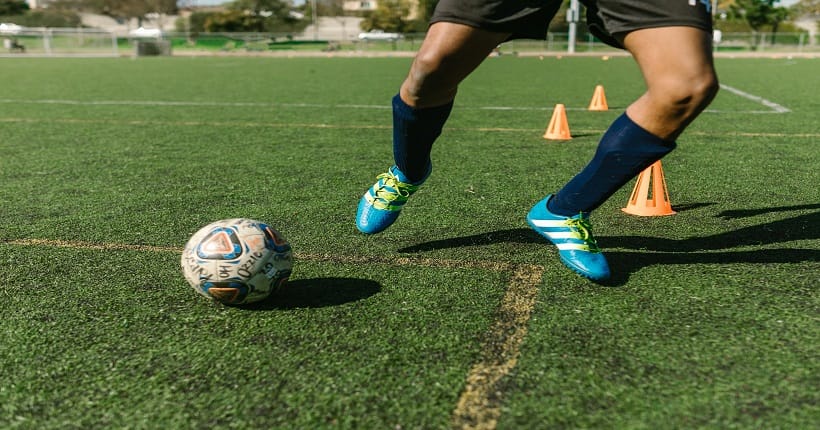How Many Panels Does A Soccer Ball Have?
A soccer ball typically has 32 panels, which are stitched together to form the spherical shape. Soccer is a sport that is loved and played by millions of people around the world.
Whether you’re kicking a ball in the park with friends or watching a professional game on TV, the soccer ball is a central part of the action. But have you ever wondered how many panels make up a soccer ball?
Well, the answer is quite simple. A soccer ball usually consists of 32 panels, which are stitched together to create the iconic round shape. Each panel is usually made of synthetic leather or other materials, and they are carefully arranged to ensure a balanced and predictable flight when the ball is kicked. So next time you’re on the field, take a moment to appreciate the craftsmanship and design that goes into making a soccer ball.
Exploring The Panels And Construction Of Soccer Balls
Understanding the construction of soccer balls is key to appreciating the intricacies of the sport. Soccer balls are made up of multiple panels, stitched together to form a spherical shape. These panels not only give the ball its structure but also impact its performance on the field. In this section, we will delve deeper into the importance of soccer ball panels, the differences between traditional and modern designs, and how different panel patterns can affect the ball’s performance.
The Importance Of Soccer Ball Panels
When it comes to soccer ball construction, the number and arrangement of the panels play a crucial role. Traditionally, soccer balls were made of 32 panels, each hexagonal or pentagonal in shape. This classic design ensured optimal roundness and stability. However, as technology advanced, manufacturers began experimenting with different panel configurations to enhance performance.
Today, soccer balls have a wide range of panel counts, ranging from 12 to 32 or even more. The number of panels affects the way the ball moves through the air, how it feels when kicked, and its overall durability. More panels allow for a greater number of seams, providing better control and responsiveness during gameplay.
Differentiating Between Traditional And Modern Soccer Ball Designs
In the past, soccer balls were typically made of genuine leather, which made them heavy and less resistant to water absorption. These traditional balls had a distinctive look with their 32 hand-stitched panels. However, modern soccer balls have evolved to incorporate synthetic materials such as polyurethane (PU) or thermoplastic polyurethane (TPU) to improve their performance.
Modern soccer balls often feature fewer panels, allowing for seamless designs and smoother surfaces. The reduction in panel count not only simplifies the manufacturing process but also ensures a more consistent and predictable flight path. Additionally, the use of synthetic materials enhances the ball’s durability and resistance to wear and tear, making it suitable for various playing conditions.
The Impact Of Panel Patterns On Soccer Ball Performance
Panel patterns on a soccer ball can have a significant influence on its behavior during gameplay. By altering the arrangement of panels, manufacturers can modify how the ball moves through the air and how players can control it. Different patterns can affect the ball’s aerodynamics, spin, and bounce characteristics.
For example, soccer balls with fewer panels tend to have flatter surfaces, allowing for smoother airflow and more predictable trajectories. On the other hand, balls with more panels may exhibit a more unpredictable flight path due to the presence of additional seams. The panel patterns also affect grip and surface contact, influencing how players can manipulate the ball with their feet.
The panels and construction of soccer balls provides insight into the evolution of the sport’s essential equipment. From traditional leather balls to modern synthetic designs, the number and arrangement of panels influence a ball’s performance on the field. Manufacturers continuously strive to create balls that offer better control, durability, and playability, making the humble soccer ball an integral part of the beautiful game.
Traditional Soccer Ball Panel Designs
The panel design of a soccer ball is not just a matter of aesthetics, but it also plays a crucial role in the ball’s flight and performance on the pitch. Over the years, different panel designs have been used in the construction of soccer balls, each with its own unique characteristics. In this article, we will delve into the world of traditional soccer ball panel designs and explore the fascinating history and evolution of these designs.
The Classic 32-panel Design: A Timeless Favorite
When we think of a traditional soccer ball, the image of a ball with 32 panels instantly comes to mind. This classic design has stood the test of time and continues to be a favorite among players and fans alike. The 32-panel design consists of 20 hexagonal and 12 pentagonal panels sewn together to create a spherical shape.
One of the key advantages of the 32-panel design is its predictable flight path. The uniform distribution of panels ensures the ball rotates evenly when kicked, leading to more accurate passes and shots. This design also provides excellent aerodynamics, allowing the ball to travel swiftly through the air.
Examining The Hexagonal And Pentagonal Panel Pattern
The hexagonal and pentagonal panel pattern used in the 32-panel design has become an iconic symbol of soccer. These shapes are carefully arranged to fit together, creating a seamless surface that is both visually appealing and functional.
Hexagons are known for their structural strength and stability, making them ideal for creating a sturdy outer layer for the ball. The pentagons, on the other hand, help create the spherical shape by filling in the gaps between the hexagons. This combination of shapes gives the ball its characteristic look and feel.
- The 32-panel design with hexagonal and pentagonal panels offers:
- Predictable flight path
- Uniform rotation
- Excellent aerodynamics
- Structural strength
- Spherical shape
The Evolution Of The 18-panel Geodesic Dome Design
In recent years, soccer ball manufacturers have explored new panel designs to enhance performance and meet the demands of modern players. One such design is the 18-panel geodesic dome. Inspired by the architectural principles of geodesic domes, this design utilizes fewer panels compared to the classic 32-panel design.
The 18-panel design features hexagonal panels that are interconnected with a combination of pentagonal and smaller hexagonal panels. This unique configuration not only reduces the number of seams but also promotes better ball control and grip, giving players a more precise touch on the ball.
| Advantages of the 18-panel geodesic dome design: |
|---|
| Better ball control |
| Improved grip |
| Reduced number of seams |
While the 18-panel geodesic dome design offers its own set of benefits, the classic 32-panel design continues to be the go-to choice for many players and soccer enthusiasts. The evolution of panel designs reflects the constant pursuit of innovation and improvement in the world of soccer, ensuring that players can experience the best possible performance on the field.
Modern Soccer Ball Innovations
Over the years, the design and construction of soccer balls have evolved significantly. Advancements in materials, technology, and manufacturing processes have revolutionized the way soccer balls are made. In this section, we will explore some of the major innovations in modern soccer ball design. From the introduction of 6-panel configurations to the development of synthetic, non-stitched panels, these advancements have not only enhanced the performance of the soccer ball but also transformed the game itself.
The Advent Of The 6-panel Soccer Ball
Boldly moving away from traditional multi-panel designs, the introduction of the 6-panel soccer ball marked a significant milestone in ball construction. Consisting of six large, hexagonal panels seamlessly stitched together, this innovative design offers several advantages. Firstly, it provides a more consistent surface for players, allowing for accurate ball control and precise kicking. The 6-panel configuration also ensures better aerodynamics, enabling faster and more stable flight through the air. These enhancements have greatly contributed to the overall performance and playability of modern soccer balls.
Unveiling The Unique Octagonal Panel Configuration
Building upon the success of the 6-panel soccer ball, manufacturers introduced the unique octagonal panel configuration. This design is characterized by twelve pentagonal and twenty hexagonal panels, which are intricately assembled to create a visually appealing and highly functional surface. The octagonal panel configuration optimizes the distribution of stress, ensuring a more durable ball that can withstand the rigorous demands of the game. Additionally, this design offers enhanced grip and accuracy, allowing players to manipulate the ball with greater precision, making it a favorite among professionals and enthusiasts alike.
The Rise Of The Synthetic, Non-stitched Panels
In recent years, soccer ball technology has taken yet another leap forward with the rise of synthetic, non-stitched panels. Traditional stitched panels require meticulous craftsmanship and are prone to wear and tear over time. Synthetic materials, on the other hand, offer increased durability and consistency. With the advent of thermally bonded or glued panel construction, manufacturers are now able to create seamless soccer balls with superior performance characteristics. These modern synthetic panels provide a reliable surface for optimal ball control, enhanced durability, and improved water resistance, making them ideal for all weather conditions.
The Future Of Soccer Ball Design: Advanced Panel Technologies
In the quest for continued innovation, soccer ball designers are exploring advanced panel technologies to unlock even greater possibilities. The future of soccer ball design lies in the development of cutting-edge materials and manufacturing techniques that can further enhance performance, durability, and flight stability. From intelligent microchip-enabled panels that track performance data to innovative panel shapes that manipulate airflow, these advancements promise to push the boundaries of what a soccer ball can achieve.
With each passing year, the world of soccer ball design continues to evolve, influenced by the pursuit of improved performance and player experience. From the 6-panel configuration to the synthetic, non-stitched panels of today, and the exciting developments on the horizon, the soccer ball will remain an iconic symbol of the sport’s constant innovation and progress.
Factors Influencing The Number Of Panels
The Relationship Between Panel Count And Durability
When it comes to the number of panels in a soccer ball, one key factor to consider is durability. The construction of a soccer ball with fewer panels tends to result in a more resilient and long-lasting product. This is due to the reduced number of seams, which are often the weak points prone to wear and tear.
Typically, traditional soccer balls have 32 panels, which allows for a good balance between durability and performance. However, there are also soccer balls with fewer panels, such as 18 or even 6-panel designs. These balls are often used in training or recreational settings where durability is a higher priority than the perfect flight or ball control.
Furthermore, the panel count can also be influenced by the materials used in the ball’s construction. While synthetic materials are often used for durability, genuine leather can provide a premium touch but may require additional panels to maintain structural integrity.
Making Sense Of The Impact On Aerodynamics And Ball Flight
The number of panels in a soccer ball also plays a role in its aerodynamics and ball flight characteristics. With fewer panels, the ball tends to have a smoother surface, reducing the overall drag as it travels through the air. This can result in a faster and more predictable ball flight.
In contrast, soccer balls with a higher panel count may have more seams and ridges, creating turbulence and affecting the aerodynamics. This can lead to unpredictable movements and a more challenging ball flight, making it a preferred choice for experienced players seeking enhanced control and challenging gameplay.
| Panel Count | Aerodynamics | Ball Flight |
|---|---|---|
| Less Panels | Reduced drag | Fast and predictable |
| Higher Panel Count | Turbulence | Unpredictable movements |
The Role Of Panel Count In Optimal Ball Control And Playability
When it comes to ball control and playability, the panel count of a soccer ball can have an impact. A higher number of panels often translates to better overall control, as the additional seams provide increased grip and better ball handling.
For professional players or those prioritizing precise passes and exceptional touch, a ball with more panels can offer the necessary control. On the other hand, balls with fewer panels may offer less grip but can still be suitable for recreational play or training sessions, especially when durability is the main concern.
To summarize, the panel count in a soccer ball directly influences its durability, aerodynamics, ball flight, as well as ball control and playability. The desired outcome will ultimately depend on the level of play, personal preferences, and specific needs of individuals or teams. Selecting a soccer ball suitable for the desired style of play ensures an enjoyable and productive experience on the field.
Debunking Common Myths Surrounding Soccer Ball Panels
When it comes to soccer balls, there are often many myths and misconceptions surrounding the number of panels they have. Many people believe that the more panels a soccer ball has, the better its performance will be. Others argue that fewer panels equate to increased precision. Additionally, some claim that complex panel designs guarantee enhanced ball control. In this article, we aim to debunk these common myths surrounding soccer ball panels and provide a clear understanding of their impact on performance and gameplay.
Myth #1: More Panels Always Mean Better Performance
One common myth surrounding soccer ball panels is that more panels always result in better performance on the field. However, this notion is simply not true. While it was once believed that more panels provided increased stability and accuracy, modern advancements in ball technology have proven otherwise. In fact, many professional soccer balls nowadays feature just 32 panels, which has become the standard in the industry.
Myth #2: Fewer Panels Equate To Increased Precision
Another prevailing myth is that fewer panels equate to increased precision while playing soccer. This misconception stems from the belief that fewer panels create smoother surfaces and allow for better control of the ball. However, research and expert opinions have shown that the number of panels does not significantly influence precision. Instead, factors such as the quality of materials, manufacturing techniques, and overall design play a more crucial role in determining a ball’s performance and accuracy.
Myth #3: Complex Panel Designs Guarantee Enhanced Ball Control
Complex panel designs have gained popularity among soccer ball enthusiasts due to the perception that they guarantee enhanced ball control. These designs, often featuring unique patterns and shapes, are believed to offer improved grip and maneuverability. While it is true that panel designs can influence a ball’s aerodynamics and flight characteristics, there is no definitive evidence that complex panel designs automatically result in enhanced ball control. Other factors such as player skill, playing conditions, and ball inflation play a significant role in determining ball control.
Debunking these common myths surrounding soccer ball panels reveals that the number of panels does not singularly determine a ball’s performance, precision, or ball control. Instead, it is a combination of multiple factors that contribute to a soccer ball’s performance on the field. By understanding the true impact of panel design and other crucial factors, players and enthusiasts can make informed decisions when choosing the right soccer ball for their needs.
Decoding The Panel Count Of Popular Soccer Ball Brands
When it comes to soccer, the design and construction of the ball play a crucial role in the game. One aspect that often intrigues soccer enthusiasts is the panel count of the soccer ball. Different soccer ball brands have their unique panel configurations, which contribute to the ball’s performance and feel on the pitch. In this article, we will dive into the panel counts of popular soccer ball brands, including Adidas, Nike, Puma, and Select.
Adidas, a leading sports brand, has been instrumental in shaping the world of soccer balls. Their commitment to balancing tradition and innovation is evident in their panel design. The classic Adidas soccer ball typically features a hexagonal panel construction, complemented by pentagonal panels that create the iconic look.
By incorporating these traditional panel shapes, Adidas ensures optimal accuracy, control, and stability in their soccer balls. These carefully designed panels provide a predictable flight trajectory and precise ball control, which are crucial for both professional players and soccer enthusiasts alike.
Nike, known for its innovation and boundary-pushing designs, takes a unique approach to panel configurations. They strive to create soccer balls that enhance players’ performance and deliver a superior playing experience. To achieve this, Nike incorporates inventive panel layouts that break away from traditional designs.
One example is the Nike Ordem IV, which features a 12-panel construction. This innovative design allows for better ball grip and enhanced aerodynamics, resulting in improved accuracy and speed during gameplay. Nike’s continuous efforts to push the boundaries of panel configurations have garnered praise from professional athletes and soccer enthusiasts worldwide.
Puma, a brand synonymous with performance and style, takes a different approach to panel count. They embrace simplicity by utilizing fewer panels in their soccer ball designs. Puma’s soccer balls typically feature a 6-panel construction, which minimizes seams and provides a clean aesthetic look.
This streamlined panel design enhances the ball’s performance by creating a consistent and smooth surface. The reduced number of panels ensures a larger striking surface area, allowing players to have increased control and accuracy when making crucial passes or shots. Puma’s commitment to simplicity and performance has made their soccer balls a go-to choice for many players worldwide.
Select, a brand that focuses on quality and precision, sets itself apart with its unique twelve panel construction. This distinctive design offers several advantages on the pitch. The additional panels allow for greater control and stability, enabling players to have a better grip on the ball.
The twelve panel configuration also enhances the ball’s trajectory and responsiveness, resulting in improved accuracy and control during gameplay. Select’s commitment to innovation and quality shines through in their panel design, making their soccer balls a favorite among players who value precision and performance.
Each soccer ball brand showcases its individuality through its panel count and design. Whether it’s Adidas with its classic hexagonal and pentagonal panels, Nike’s inventive 12-panel configurations, Puma’s streamlined 6-panel construction, or Select’s unique twelve panel design, these brands consistently strive to deliver soccer balls that enhance players’ performance and overall enjoyment of the game.
Choosing The Right Soccer Ball For Your Needs
When it comes to playing soccer, having the right equipment can make all the difference in your game. One of the most essential pieces of equipment is the soccer ball. However, with so many options available on the market, it can be confusing to know which one is right for you. One factor to consider when choosing a soccer ball is the panel count.
Considering The Panel Count Based On Skill Level
The panel count of a soccer ball refers to the number of panels or sections that make up the ball’s outer surface. The traditional soccer ball consists of 32 panels, but there are variations available. The panel count can have an impact on how the ball behaves when it is in motion, as well as the level of control and accuracy you can achieve.
For beginners or younger players who are just starting to develop their skills, a soccer ball with a higher panel count may be suitable. This is because a higher panel count generally provides more stability and a larger sweet spot, making it easier to control and strike the ball. A ball with 32 panels can offer better control and stability, which can be beneficial for players who are still learning the fundamentals of the game.
On the other hand, for more advanced players who have honed their skills and are looking for more responsiveness and precision in their gameplay, a soccer ball with a lower panel count may be preferred. Balls with a lower panel count, such as those with 18 or 12 panels, tend to have a smoother surface and offer less air resistance, allowing for sharper and more accurate passes and shots. These balls are often used in professional matches, where players require maximum control and a higher level of play.
The Relationship Between Panel Count And Price Range
The panel count of a soccer ball can also have an impact on its price. Generally, soccer balls with a higher panel count tend to be more expensive than those with a lower panel count. This is because the manufacturing process for balls with more panels requires more time and resources.
If you’re just starting out or playing as a hobby, a soccer ball with a higher panel count may be more affordable and still provide you with a good level of performance. However, if you’re a serious player or have aspirations of playing at a higher level, investing in a soccer ball with a lower panel count may be worth considering, despite the higher price tag. These balls offer superior performance and durability, making them a worthwhile investment for dedicated players.
Personalizing Your Playing Experience: Panel Count Preferences
Ultimately, the choice of panel count is a matter of personal preference. Some players may find that a high panel count offers the best balance of control and stability, while others may prefer the responsiveness and precision offered by a low panel count ball. It’s important to experiment with different panel counts to find the one that suits your playing style and needs.

Credit: m.youtube.com
Frequently Asked Questions Of How Many Panels Does A Soccer Ball Have?
Why Are There 32 Panels On A Soccer Ball?
A soccer ball has 32 panels to maintain its shape and ensure consistent flight and control during play.
How Many Panels Are Best For Soccer Ball?
The best soccer balls usually have 32 panels.
How Many Panels Does A Modern Soccer Ball Have?
A modern soccer ball typically has 32 panels.
How Many Panels Does A Football Have?
A football typically has 32 panels.
How Many Panels Does A Soccer Ball Have?
A standard soccer ball usually has 32 panels stitched together to form its iconic hexagonal pattern.
Conclusion
To wrap up, the number of panels in a soccer ball determines its design and performance on the field. While traditionally, soccer balls were made with 32 panels, newer designs have come with fewer or more panels. The evolution of ball construction has made it possible to enhance aerodynamics, durability, and overall playability.
So next time you kick a soccer ball, take a moment to appreciate the intricacies of its panel arrangement, knowing that each panel contributes to the beautiful game we all love.







